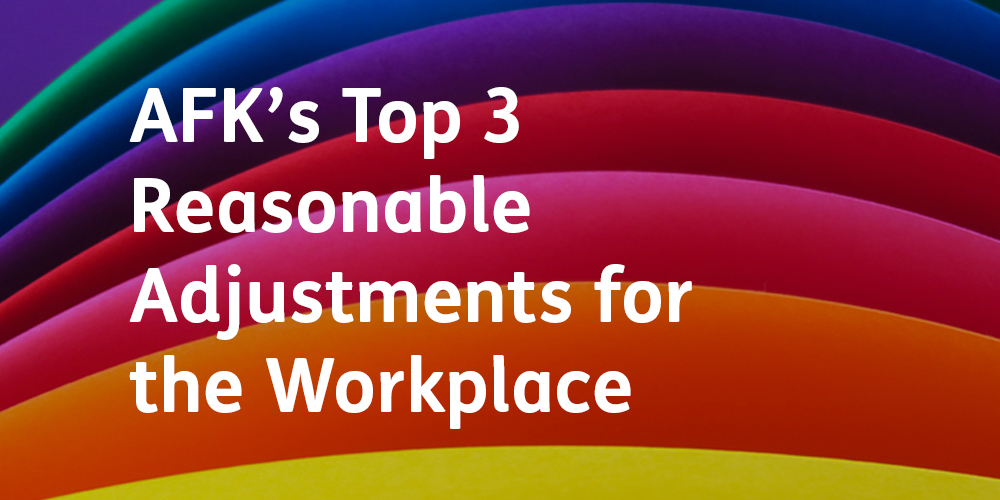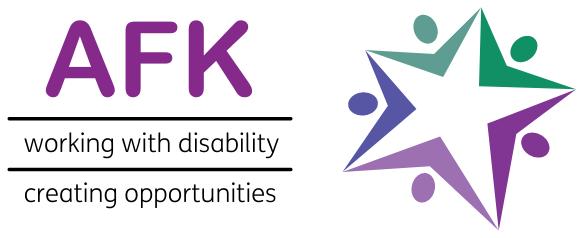AFK's Top 3 Reasonable Adjustments for the Workplace

Reasonable adjustments are changes that can be made in the workplace to make the environment and work processes more accessible, reducing the effect of a person’s difficulty or disability, allowing them to do their job with minimal barriers.
When most people think of accessibility, their first thoughts are about physical accessibility: ramps and lifts. True accessibility in the workplace goes far beyond that, and is often much easier to put in place!
AFK has been working closely with a growing network of employers for two decades to provide meaningful job opportunities to young people with physical and learning disabilities and autism spectrum conditions.
In that time, we’ve learned a lot about what makes a workplace more (or less) easy to navigate for the young people we support. The great thing is – most of these changes cost little or nothing at all, but often have a huge impact on every single member of staff, as well as customers, clients and other stakeholders.
So here are our Top 3 Reasonable Adjustments for the Workplace, all of which cost little to nothing to put in place but can make a world of difference to all your staff.
1. Clear signage

Clear signs and notices make a workplace easier to navigate for everyone who steps through the door. We all remember what it was like on our first day of work, or school, not knowing where anything was and perhaps feeling too nervous to ask. Having key areas, materials and other information clearly displayed allows everyone to be more confident and productive in a workspace.
A few tips: Have signs at wheelchair level – not everyone looks up – and make sure the signs are large with high contrast text in a simple font. Use a dark print on a light background for optimal visibility and readability. Again, the proper use of colour makes the world of difference – have large signs too. For bonus points, add colourful directional arrows on walls or floors as appropriate – these help everyone find what they need.
2. Colour coding

Everyone loves a bit of colour coding, but it’s underused by so many! It’s a simple yet powerful change that makes everyday tasks so much simpler and more productive for ALL staff. Colours bring environments to life but they also have their place with everyday paperwork. Using colours make it easier to define different areas of work and can help if you’re tired and looking for something quickly, as well as assist those with visual impairments.
Some buildings already have different colours for different floors where they use a colour block near the lift area or an ongoing stripe around the walls. We used the example of a hospital above. Hospitals use clear signs and colour coding really well, because the designers of these spaces know that when you’re in a hospital (either as a patient or a visitor) you’re more likely to be experiencing stress, which makes it harder to think about where you are or need to go. We’re sure even the staff appreciate the help of colour coded floor signs when they’re finishing a long shift!
3. Simple language

Simple language is key, for both written and verbal communication. Here are some of the most important things to remember:
- Stick to simple sentences and vocabulary
- Use a simple font with a minimum font size of 12 (or preferably 14, which greatly improves readability)
- Avoid acronyms unless absolutely necessary, and if you need to use them then have a key handy
- If you talk quickly, you will need to slow down a little. Often a trainee with learning disabilities or autism will nod politely to a helpful staff member who was talking at speed, but when asked afterwards, they don’t remember or understand what was said as it was too fast.
- Ask one question at a time, check understanding, then move onto another question. Take your time and have the young person write key points down too – though not everything, as you want them to exercise their memory as well!
We hope this list gives you some food for thought on how to make your workplace more accessible for all.
If you have any questions or would like additional support from our team, please email [email protected] or call 020 8347 8111 and ask to speak to Elaine Harman, our Life and Work Manager.
